
The results of a recent study by Japanese scientists from The Graduate School of Natural Sciences at Osaka University has demonstrated the ability of corals to switch their light sensitivity between ultraviolet and visible light, using chlorine ions.
This discovery offers a new approach to understanding protein engineering. It fundamentally changes the scientific understanding of light-sensitive proteins opsins, which are responsible for vision.
In animals, most opsins a negatively charged amino acid acts as a counterion, ensuring the absorption of visible light. The study found, that some coral opsins use chlorine ions for this purpose from the environment.
This demonstrates, how corals, which do not have eyes, can sense and respond to light. It also provides scientists with insight into, how corals respond to threats from climate change, among other things, ocean acidification.
As part of the research, japanese scientists studied, how the Acropora tenuis coral captures light and reacts to changing conditions in the ocean. Like many other organisms, corals use opsin proteins — the same family of light-sensitive proteins found in the retina of the human eye — to detect light in the environment. In particular, the researchers were able to identify a previously unknown group of opsins.
These are the ASO-II opsins, which have unique properties, that distinguish corals from mammals. Through mutation experiments, using spectroscopy and targeted advanced modeling, the researchers focused on the mechanism of light sensitivity of opsin Antho2a.
Instead of the amino acids used in animal opsins, ASO-II uses chlorine ions. This is the first case of inorganic ions being used in this way.
“We found, that chlorine ions stabilize Schiff’s base less well than amino acids. Thus, the opsin can reversibly switch between sensitivity to visible light and UV sensitivity depending on pH”, — explained the study’s first author, a researcher at the Terakita lab Yusuke Sakai.
In conditions of high acidity, coral opsins respond to visible light, and in conditions of high alkalinity — to ultraviolet light. This ability may be related to the close interaction between corals and algae, as algae living inside coral cells change the internal pH in the process of photosynthesis. The light sensitivity of corals can be changed in real time, allowing for fine-tuning of the interaction between corals and algae.
“The Acropora tenuis opsin ASO-II regulates calcium ions in a light-dependent manner, indicating its potential use as an optogenetic tool, whose wavelength sensitivity varies with pH”, — says one of the study’s lead authors, professor Mitsumasa Koyanagi.
Scientists hope, that the unique ability of corals to change their own light sensitivity depending on the pH, can be used to develop new forms of light control in biology and medicine.
The results of the study are published in the journal ELife
Source: Interesting Engineering

Spelling error report
The following text will be sent to our editors: